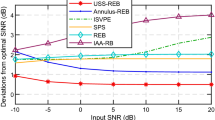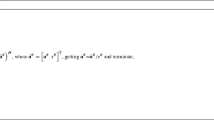Abstract
If there is a mismatch between the assumed steering vector (SV) and the real value, the performance of adaptive beamforming methods is degraded. When the signal SV is known exactly but the sample size is small, the performance degradation can also occur. The second kind of degradation is mainly due to the mismatch between the sample covariance matrix and the real one. Almost all existing robust adaptive beamformers are proposed to improve the robustness against these two types of mismatch. Indeed, most of them are user parameter dependent, and the user parameter-free robust beamformers are scarce. As one of the shrinkage methods, the general linear combination (GLC) based beamformer is a good user parameter-free robust beamformer. However, it is only suitable for the scenarios with low sample size and/or small SV mismatch. In this paper, we propose a new robust beamformer, and it is based on general linear combination in tandem with SV estimation (GLCSVE). The proposed approach is superior to GLC in two aspects. One is that the GLCSVE beamformer performs well not only with small but also with large sample size. The other is that the GLCSVE can effectively deal with a large range of SV mismatch. Moreover, the proposed GLCSVE approach is a user parameter-free robust beamformer, and is more suitable for application than the parameter dependent approaches. The idea of our method can also be used to enhance other shrinkage based beamformers.







Similar content being viewed by others
References
Johnson, D. H., & Dudgeon, D. E. (1993). Array signal processing: Concepts and techniques. Englewood Cliffs, NJ: Prentice-Hall.
Monzingo, R. A., & Miller, T. W. (1980). Introduction to adaptive arrays. New York: Wiley.
Hudson, J. E. (1981). Adaptive array principles. Stevenage, UK: Peregrinus.
Capon, J. (1969). High-resolution frequency wavenumber spectrum analysis. Proceedings of the IEEE, 57(8), 1408–1418.
Li, J., & Stoica, P. (2006). Robust adaptive beamforming. New York: Wiley.
Carlson, B. D. (1988). Covariance matrix estimation errors and diagonal loading in adaptive arrays. IEEE Transactions on Aerospace and Electronic Systems, 24(4), 397–401.
Feldman, D. D., & Griffiths, L. J. (1994). A projection approach for robust adaptive beamforming. IEEE Transactions on Signal Processing, 42(4), 867–876.
Vorobyov, S. A., Gershman, A. B., & Luo, Z. Q. (2003). Robust adaptive beamforming using worst-case performance optimization: A solution to the signal mismatch problem. IEEE Transactions on Signal Processing, 51(2), 313–324.
Li, J., Stoica, P., & Wang, Z. (2003). On robust Capon beamforming and diagonal loading. IEEE Transactions on Signal Processing, 51(7), 1702–1715.
Lorenz, R. G., & Boyd, S. P. (2005). Robust minimum variance beamforming. IEEE Transactions on Signal Processing, 53(5), 1684–1696.
Vorobyov, S. A., Gershman, A. B., Luo, Z. Q., & Ma, N. (2004). Adaptive beamforming with joint robustness against mismatched signal steering vector and interference nonstationarity. IEEE Signal Processing Letters, 11(2), 108–111.
Shahbazpanahi, S., Gershman, A. B., Luo, Z. Q., & Wong, K. M. (2003). Robust adaptive beamforming for general-rank signal models. IEEE Transactions on Signal Processing, 51(9), 2257–2269.
Yu, Z. L., Ser, W., Er, M. H., Gu, Z., & Li, Y. (2009). Robust adaptive beamformers based on worst-case optimization and constraints on magnitude response. IEEE Transactions on Signal Processing, 57(7), 2615–2628.
Yu, Z. L., Gu, Z., Zhou, J., Li, Y., Ser, W., & Er, M. H. (2010). A robust adaptive beamformer based on worst-case semi-definite programming. IEEE Transactions on Signal Processing, 58(11), 5914–5919.
Liao, B., Tsui, K. M., & Chan, S. C. (2011). Robust beamforming with magnitude response constraints using iterative second-order cone programming. IEEE Transactions on Antennas and Propagation, 59(9), 3477–3482.
Wu, S.P., Boyd, S., & Vandenberghe, L. (1998). FIR filter design via spectral factorization and convex optimization. In B. Datta (Ed.), Applied computational control, signal and communications (pp. 1–33). Cambridge, MA: Birkhäuser, 1.
Tsui, K. M., & Chan, S. C. (2010). Pattern synthesis of narrowband conformal arrays using iterative second-order cone programming. IEEE Transactions on Antennas and Propagation, 58(6), 1959–1970.
Du, L., Li, J., & Stoica, P. (2010). Fully automatic computation of diagonal loading levels for robust adaptive beamforming. IEEE Transactions on Aerospace and Electronic Systems, 46(1), 449–458.
Du, L., Yardibi, T., Li, J., & Stoica, P. (2009). Review of user parameter-free robust adaptive beamforming algorithms. Digital Signal Processing, 19(4), 567–582.
Selen, Y., Abrahamsson, R., & Stoica, P. (2008). Automatic robust adaptive beamforming via ridge regression. Signal Processing, 88(1), 33–49.
Stoica, P., Li, J., Zhu, X., & Guerci, J. R. (2008). On using a priori knowledge in space–time adaptive processing. IEEE Transactions on Signal Processing, 56(6), 2598–2602.
Chen, Y., Wiesel, A., Eldar, Y. C., & Hero, A. O. (2010). Shrinkage algorithms for MMSE covariance estimation. IEEE Transactions on Signal Processing, 58(10), 5016–5029.
Ledoit, O., & Wolf, M. (2004). A well-conditioned estimator for large-dimensional covariance matrices. Journal of Multivariate Analysis, 88(2), 365–411.
Er, M. H., & Ng, B. C. (1994). A new approach to robust beamforming in the presence of steering vectors errors. IEEE Transactions on Signal Processing, 42(7), 1826–1829.
Gu, Y. J., Zhu, W. P., & Swamy, M. N. (2010). Adaptive beamforming with joint robustness against covariance matrix uncertainty and signal steering vector mismatch. Electronics Letters, 46(1), 86–88.
Hassanien, A., Vorobyov, S. A., & Wong, K. M. (2008). Robust adaptive beamforming using sequential quadratic programming: An iterative solution to the mismatch problem. IEEE Signal Processing Letters, 15(9), 733–736.
Acknowledgments
This work was supported by the National Natural Science Foundation of China under grants 61179004 and 61179005.
Author information
Authors and Affiliations
Corresponding author
Rights and permissions
About this article
Cite this article
Jin, W., Jia, W., Zhang, F. et al. A User Parameter-Free Robust Adaptive Beamformer Based on General Linear Combination in Tandem with Steering Vector Estimation. Wireless Pers Commun 75, 1447–1462 (2014). https://doi.org/10.1007/s11277-013-1432-1
Published:
Issue Date:
DOI: https://doi.org/10.1007/s11277-013-1432-1




